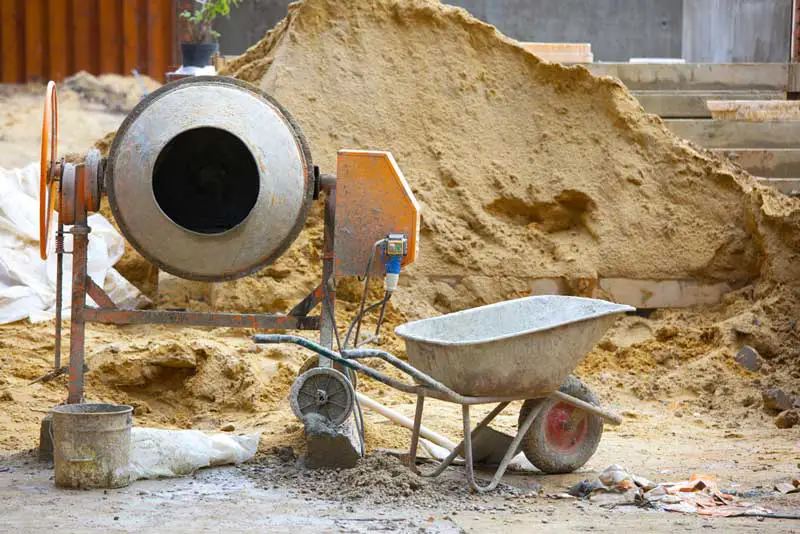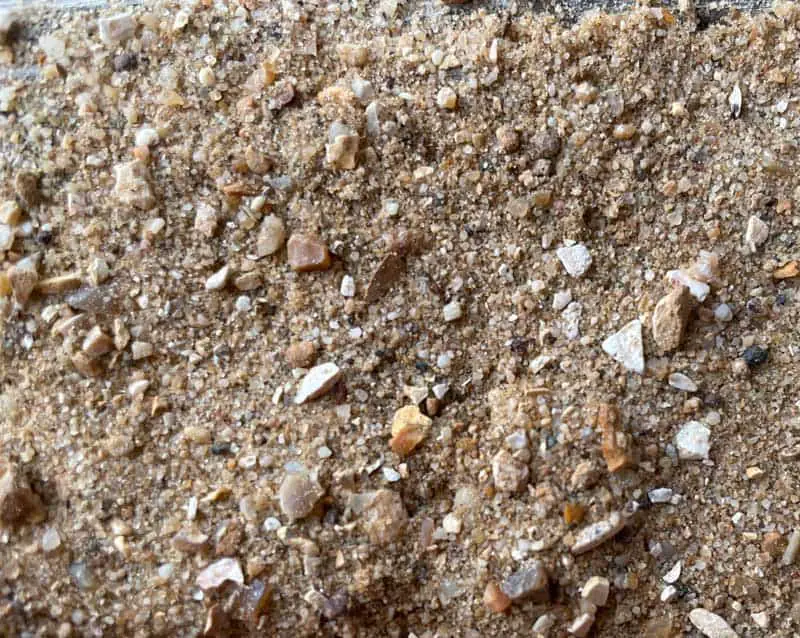
Lime mortars are made by mixing together the binder, either lime putty or hydraulic lime and various sands and aggregates. It’s essential to use the correct sands and aggregates for lime mortars as they strongly affect the strength and durability of the finished mortar. So what sands should be used to make lime mortars?
Lime mortars should always be made using well-graded, sharp-washed sand. You can perform a visual inspection to see if the sand meets these criteria. The sand should appear to have a good balance of fine, medium and coarse particles. It should be washed of impurities such as clay, silt and plant matter. Finally, the particles should be sharp and angular looking, not rounded and soft. Sand which is soft will lead to excessive shrinking and a poor lime mortar.
Many building sands today are softer, this is to compensate for the very poor workability of Portland cement-based mortars. When picking up sand for use with lime, it must be sharp-washed sand. Let’s go a bit more in detail to see why it’s so important that the correct sand is used with lime mortars.
Why is Sharp-washed Sand so Important?
So you may be wondering why it’s so important to get the sand and aggregates correct with lime mortars. After all, isn’t sand just sand? Unfortunately not, there are many different types and grades of sand. Below I’ll explain each component of good sand for use with lime mortars and why it’s necessary.
Well-graded Sand
The grading of sand refers to the amount of small, medium and large particles. Lime mortars, plasters and renders can use sand from 8mm down to 40 microns in size. As a general rule for lime mortars, the latest particle size shouldn’t be any wider than a third of the joint you intend to point. For example, if you have a 6mm joint, you would be able to use sand which has been graded to 2mm. This means the sand used will have a maximum particle size of 2mm but will have a good range of 2mm down to small particles in the sand.
Well-graded sand is important for lime mortars because it allows all of the particles to interlock and form a strong bond. If you had too many large particles there would be many gaps in between, leading to a weak mortar. Therefore, it’s important that no matter what sand you use for lime mortars, it must have a good ratio of small, medium and large particles. You can usually visually check this by picking the sand up in your hand to see if there’s plenty of each size visible.
Sharp and Washed Sand
Sharp sand refers to the shape of the particles that are in it. Sands used for lime mortars should be angular and sharp. They should not roll around easily when rubbed between the fingers. When the sand particles are angular and sharp they will lock together to form a strong mortar. Soft sand with rounded particles will lead to excessive shrinkage in plasters and poor-strength lime mortars.
Related article: What Happens If Mortar Is Too Strong?
Washing or purchasing washed sand is important to remove impurities in the sand. Clay, soil, dust, vegetation and other impurities must be removed as they can lead to a weaker mortar. Some lime mortars have additives such as dust put back in with the mix to help match old mortars. These are specially added to give the mortar a specific characteristic. Having sand with impurities in it from the beginning can lead to unforeseen properties in the mortar.

The sand pictured above is a 4mm down coarse sharp washed building sand. It’s perfect for making lime mortars. If you look closely you can see a good balance of particle size within the sand. In addition to that, notice how even the smallest of the particles are angular and not smooth. Mortars made using this sand will be strong, durable and won’t have issues with excessive shrinkage. I purchased this sand from Limebase.
Check out this guide on how long you should expect lime mortars to last.
What Ratio of Sand to Lime Should You Use?
Once you have good sharp-washed sand, it’s important to get the ratio for lime to aggregate correct. Below is a table with some of the most commonly used ratios. It’s important to note, the finer the sand used, the more likely hydraulic lime will fail. Lime putty is best for use with fine sand. Superfine lime putty can be mixed with superfine sand to create a fantastic lime skim coat.
| Type of Application | The ratio of Lime : Aggregate | Most commonly used |
| Lime Mortars (Lime putty-based or Hydraulic Lime) | 1:3, 1:2.5 or 1:2 | 1:3 |
| Lime Plasters & Renders (Lime putty-based will work best) | 1:3, 1:2.5 or 1:2 | 1:2.5 |
| Lime Skim Coats (Superfine lime putty only) | 1:2 or 1:1 | 1:2 |
When making lime mortars, plasters and renders, hydrated lime should never be used. It is an inferior product when compared to lime putty and hydraulic limes. Hydrated lime is only ever intended to be used with Portland cement mortars as a plasticiser. Mortars or plasters made with hydrated lime will most likely fail or be extremely weak.
Other Additives For Lime Mortars
When building or making repairs with lime, you will soon notice how versatile it can be. There are thousands of potential additives and different mixes that can be used. An additive for lime mortar can help to achieve a desired aesthetic, texture or set time. For example, many lime mortars for use with hamstone will include a small amount of hamstone dust to give the mortar a warm orange appearance that complements the stone it is used with.
Related article: How Long Does Lime Mortar And Plaster Remain Workable?
In the eighteenth century, wood ash was added to many lime mortars. This is an artificial pozzolan, which is an aggregate that helps to speed up the set time of lime mortars. Today, wood ash can still be used in lime mortars. Wood ash can be hard to get hold of, so a common practice when trying to match these old wood ash mortars is to add a small amount of black grit to the mortar. Black grit helps to mimic the black fleck that was common with old mortars without the need for using wood ash.

